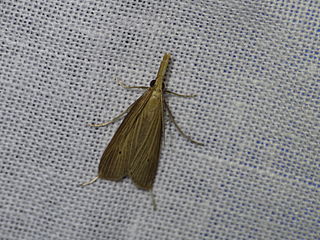
Donacaula is a genus of moths of the family Crambidae. The genus was erected by Edward Meyrick in 1890.
Vaxi tripsacas is a moth in the family Crambidae. It was described by Harrison Gray Dyar Jr. in 1921. It is found in North America, where it has been recorded from Florida and Alabama. It is also present on the West Indies. The habitat consists of coastal dunes.
Parambia gnomosynalis is a moth in the family Crambidae. It was described by Harrison Gray Dyar Jr. in 1914. It is found from Guatemala south through Central America to northern South America.
Donacaula pulverealis is a moth in the family Crambidae. It was described by George Hampson in 1919. It is found in Brazil and Bolivia.
Donacaula semifuscalis is a moth in the family Crambidae. It was described by George Hampson in 1919. It is found in the Brazilian states of Mato Grosso and Pernambuco and in Bolivia.
Donacaula albicostella is a moth in the family Crambidae. It was described by Charles H. Fernald in 1888. It is found in North America, where it has been recorded from Alberta, British Columbia, Manitoba, California, Connecticut, Illinois, Maine, Massachusetts, Michigan, Minnesota, New Jersey, Utah and Wisconsin.
Donacaula aquilella is a moth in the family Crambidae. It was described by James Brackenridge Clemens in 1860. It is found in North America, where it has been recorded from Alabama, Georgia, Massachusetts, Mississippi, New Jersey, New York, North Carolina and South Carolina.
Donacaula immanis is a moth in the family Crambidae. It was described by Philipp Christoph Zeller in 1877. It is found in Bolivia and the Brazilian states of Amazonas and Rio Grande do Sul.
Donacaula longirostrallus, the long-beaked donacaula moth, is a moth in the family Crambidae. It was described by James Brackenridge Clemens in 1860. It is found in North America, where it has been recorded from Nova Scotia, Ontario, Quebec, Alabama, Arkansas, Connecticut, Florida, Louisiana, Maine, Massachusetts, Michigan, Mississippi, Nebraska, New Jersey, New York, North Carolina, Pennsylvania, Texas, Vermont and Virginia.
Donacaula maximellus is a moth in the family Crambidae. It was described by Charles H. Fernald in 1891. It is found in North America, where it has been recorded from Florida, Georgia, Louisiana, Mississippi, Nebraska, North Carolina and South Carolina.

Donacaula melinella is a moth in the family Crambidae. It was described by James Brackenridge Clemens in 1860. It is found in North America, where it has been recorded from Ontario, Alabama, Arizona, Arkansas, Connecticut, Delaware, Florida, Georgia, Illinois, Indiana, Kentucky, Louisiana, Maine, Maryland, Massachusetts, Michigan, Mississippi, Nebraska, New Jersey, New York, North Carolina, Pennsylvania, South Carolina, Texas and Virginia.
Donacaula microforficellus is a moth in the family Crambidae. It was described by Hans Georg Amsel in 1956. It is found in Venezuela.
Donacaula nitidellus is a moth in the family Crambidae. It was described by Harrison Gray Dyar Jr. in 1917. It is found in North America, where it has been recorded from Alberta, Alabama, Connecticut, Georgia, Maryland, Massachusetts, Mississippi, New Jersey, New York, North Carolina, South Carolina and Texas.
Donacaula pallulellus is a moth in the family Crambidae. It was described by William Barnes and James Halliday McDunnough in 1912. It is found in North America, where it has been recorded from Alabama, Arizona, California, New York and Texas.
Donacaula porrectellus is a moth in the family Crambidae. It was described by Francis Walker in 1863. It is found in Bolivia, Brazil, Guyana, Peru and Venezuela.

Donacaula roscidellus, the brown donacaula moth, is a moth in the family Crambidae. It was described by Harrison Gray Dyar Jr. in 1917. It is found in Mexico (Veracruz) and the United States, where it has been recorded from Florida, Kentucky, Louisiana, Mississippi and Texas.
Donacaula tripunctellus is a moth in the family Crambidae. It was described by Robinson in 1870. It is found in North America, where it has been recorded from Arkansas, Florida, Louisiana, Mississippi, Oklahoma and Texas.
Donacaula unipunctellus is a moth in the family Crambidae. It was described by Robinson in 1870. It is found in North America, where it has been recorded from Nova Scotia, Alabama, Florida, Georgia, Louisiana, Maine, Mississippi, New Jersey, New York, North Carolina, South Carolina, Texas, Utah and Virginia.
Eudonia extincta is a moth in the family Crambidae. It was described by Harrison Gray Dyar Jr. in 1921. It is found in the Distrito Federal of Mexico.
Eudonia ycarda is a moth in the family Crambidae. It was described by Harrison Gray Dyar Jr. in 1929. It is found in Guatemala and Orizaba, Mexico.


